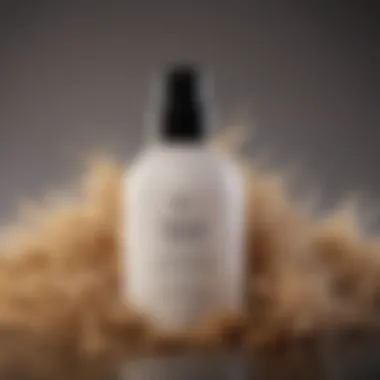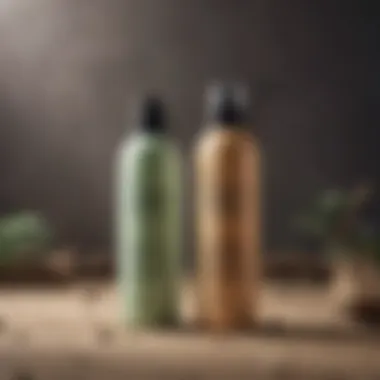Discovering the Safest Dry Shampoo Options


Intro
The world of beauty and personal care is evolving. More consumers seek products that are not only effective but also safe for health and the environment. Dry shampoo is a staple in many beauty routines, providing convenience and time-saving benefits. However, the increasing scrutiny of its ingredients raises important questions. What are the potential risks associated with conventional dry shampoos? How can one identify safer alternatives? This guide aims to address these concerns by examining the ingredients commonly found in dry shampoos, their potential health effects, and the brands that prioritize less toxic components.
In this exploration, we will dive into current trends in beauty innovation, understand their implications, and offer detailed insights into product reviews. Most importantly, we will equip readers with the necessary knowledge to make informed choices when selecting dry shampoos. As we embark on this journey, it’s vital to understand the significance of ingredient transparency and efficacy in beauty products.
Intro to Dry Shampoo
The topic of dry shampoo has gained significant attention in recent years, especially as individuals become more conscious of their self-care products. The relevance lies not just in aesthetics but also in the effects that hair products can have on overall health. Understanding dry shampoo involves recognizing its definition, its purpose, and its place in modern hair care routines.
Definition and Purpose
Dry shampoo serves as a convenient solution for individuals looking to refresh their hair without the need for traditional washing. Essentially, it is a powder or spray that absorbs excess oils and dirt from the scalp and hair, providing a cleaner appearance and extending the time between washes. The primary purpose is to maintain hairstyles longer and reduce the frequency of washing, which can strip natural oils and lead to dry or damaged hair.
Popularity in Modern Hair Care
The surge in popularity of dry shampoo can be attributed to several factors. Busy lifestyles compel many people to find efficient ways to manage their hair care routines. Moreover, there is growing awareness of the effects frequent washing can have on hair health, culminating in a shift toward products that support a more sustainable approach.
Dry shampoo is not only about convenience. It has also become a staple for those who wish to avoid potential damage associated with heat styling and chemical treatments. This growing trend emphasizes the need for less toxic formulations, which can provide an appealing alternative in personal grooming without compromising health.
Understanding Toxicity in Hair Products
The topic of toxicity in hair products is vital for informed choices regarding personal care. The ingredients in dry shampoos can range from benign to potentially harmful. Understanding which components may pose health risks helps consumers select safer options that align with their principles of health and sustainability.
Common Harmful Ingredients
Parabens
Parabens are a class of preservatives commonly used in cosmetic products to prevent microbial growth. While their ability to extend shelf life makes them a popular ingredient, there is growing concern about their safety. Research suggests that parabens can mimic estrogen in the body, leading to potential hormonal imbalances. Because of this, their presence in dry shampoos raises questions about long-term health impacts.
Sulfates
Sulfates are surfactants that create lather in products. They are effective at removing dirt and oil but can strip natural oils from the hair and scalp. This can lead to dryness or irritation. Many individuals with sensitive skin experience discomfort or allergic reactions due to sulfates. Despite their cleansing effectiveness, alternatives are often sought for less harsh effects.
Phthalates
Phthalates are used to enhance fragrance and to increase product flexibility. They are often not listed expressly on labels, which complicates consumer awareness. Phthalates have been linked to various health issues, including reproductive harm and endocrine disruption. This hidden nature in formulations can make it difficult for consumers to avoid them.
Artificial Fragrances
Artificial fragrances are synthetically produced scents that can mask unpleasant odors. However, they may harbor unknown chemicals that can trigger allergies and sensitivities. The lack of transparency in what constitutes an 'artificial fragrance' warrants caution. Some people may experience severe reactions, making fragrance-free options more appealing.
Propylene Glycol
Propylene glycol functions as a humectant, keeping products moist. It can also irritate sensitive skin and cause allergic reactions. While generally recognized as safe in small quantities, its presence in dry shampoos may raise eyebrows among consumers aiming to reduce exposure to synthetic ingredients. This calls for awareness when choosing hair products.
Potential Health Risks


Allergies and Irritations
Allergies and irritations from hair products can manifest as redness, itching, or rashes. Ingredients that may cause such reactions include parabens, sulfates, and fragrances. Understanding personal sensitivities plays a key role in identifying suitable dry shampoos. Ensuring suitable products can minimize unpleasant outcomes and maintain hair health.
Endocrine Disruption
Endocrine disruption is a significant concern when it comes to certain chemicals in personal care products. Ingredients like parabens and phthalates may interfere with hormonal balance. Prolonged exposure to these substances raises the stakes for long-term health effects. Selecting safer alternatives mitigates such risks, making informed choices essential.
Long-term Exposure Effects
Long-term exposure to harmful ingredients can lead to chronic health issues. Potential effects may include allergies, hormonal changes, and other unrecognized illnesses. Being aware of cumulative exposure from daily hair care products and addressing ingredient safety is crucial. Knowledge empowers consumers to select products that promote a healthier lifestyle.
"Understanding the toxic elements in everyday products leads to more informed choices, especially in hair care."
In summary, recognizing toxic components in dry shampoos is an ongoing health consideration. By familiarizing oneself with common harmful ingredients, individuals can better navigate their choices, prioritize safety, and embrace a healthier approach to hair care.
Evaluating Dry Shampoo Formulations
Evaluating dry shampoo formulations is crucial in the search for safer hair care products. Not all dry shampoos are created equal; understanding what goes into these products can significantly impact health and overall satisfaction with use. Knowledge of the right ingredients can help consumers choose products that align with their values, focusing on health, sustainability, and effective hair care. This section explores key ingredients and label awareness, both of which are essential in making informed decisions when selecting a dry shampoo.
Key Ingredients in Safe Dry Shampoos
Natural Absorbents
Natural absorbents, such as rice starch and cornstarch, play an important role in dry shampoos. These ingredients effectively soak up excess oil from the scalp and hair without causing buildup. The key characteristic of natural absorbents is their ability to provide oil control while being gentle on the hair and scalp.
Using natural absorbents is beneficial as they often come from renewable resources and are less likely to cause adverse reactions compared to synthetic alternatives. However, one must ensure that these ingredients are pure and free from additives to maximize their advantages.
Organic Oils
Organic oils, like jojoba and argan oil, are often incorporated into dry shampoos not just for their moisturizing properties but also for compatibility with a variety of hair types. One significant aspect of organic oils is their nutritional benefits. They can nourish the hair while providing a protective layer against environmental damage.
The unique feature of organic oils lies in their natural composition. This can make them a popular choice among consumers looking for products without synthetic chemicals. On the downside, if too much oil is used, it can weigh the hair down, leading to a greasy appearance instead of the desired clean look.
Herbal Extracts
Herbal extracts, such as rosemary and chamomile, add another layer of benefits to dry shampoos. These ingredients often possess antimicrobials and soothing properties which can be advantageous for the scalp health. The fundamental characteristic of herbal extracts is their natural origin, making them appealing to those prioritizing plant-based options.
Incorporating herbal extracts can enhance the user experience by providing a pleasant scent and nourishing the scalp. However, some individuals may have sensitivities to certain herbs, so it is crucial to test products containing them.
Understanding Labels and Certifications
Natural vs. Organic
Differentiating between "natural" and "organic" on product labels is important for consumers aiming for safer choices. Natural products may contain a mixture of synthetic and natural ingredients, while organic products adhere to stricter guidelines and are mostly free from chemicals and pesticides.
Choosing organic can be beneficial as it usually means a higher level of purity. However, not all brands may be certified organic, creating challenges for consumers in making informed choices.
Vegan and Cruelty-Free Certifications


Vegan and cruelty-free certifications are also key elements to consider when evaluating dry shampoos. Products that are labeled vegan do not contain any animal-derived ingredients. Cruelty-free labels indicate that the product has not been tested on animals.
This is essential for consumers who advocate for animal rights and sustainability. However, it is worth noting that the terms might not always be regulated strictly, leading to possible discrepancies in labeling. Thus, it is advisable to research brands to ensure the authenticity of their claims.
Understanding and taking the time to evaluate dry shampoo formulations can lead to healthier choices that aid in both personal well-being and environmental sustainability.
Top Brands of Least Toxic Dry Shampoo
The selection of dry shampoos on the market can be overwhelming, particularly for consumers who prioritize health and safety. Among these products, some brands stand out for their commitment to formulating less toxic options. By understanding the values and practices behind these brands, consumers can make informed choices that align with their lifestyles.
Prioritizing brands that focus on natural ingredients and sustainable practices not only benefits individual health but also the environment. Sustainable production methods, eco-friendly packaging, and responsible sourcing all contribute to a reduced ecological footprint. Additionally, choosing less toxic dry shampoos reduces exposure to potentially harmful chemicals, making them safer alternatives for regular use.
This section will explore three top brands recognized for their low toxicity levels, giving users insight into their formulations and practices.
Brand A: Overview and Ingredients
Brand A is renowned for its focus on clean and effective hair care solutions. The formulations include natural absorbents such as rice starch and oat powder, which help to soak up excess oil without causing irritation to the scalp.
Their products are free from parabens, sulfates, and artificial fragrances, appealing to those concerned about chemical exposure. User reviews often highlight the lightweight texture and long-lasting effects, proving that safer formulations can still deliver on performance.
It is also worth noting that Brand A offers a range of scents derived from organic essential oils, adding an aromatic yet subtle fragrance to the experience, enhancing the overall appeal without compromising safety.
Brand B: Overview and Ingredients
Brand B takes an innovative approach by merging traditional dry shampoo effectiveness with organic ingredients. The primary components include kaolin clay and cornstarch, both known for their oil-absorbing properties. This brand positions itself as a frontrunner in the realm of vegan and cruelty-free options, appealing to the ethically conscious consumer.
Feedback often emphasizes the product's ability to refresh hair while providing a clean and airy feel. Customers appreciate the absence of synthetic dyes and fragrances, which means users can enjoy a product that prioritizes both health and aesthetics.
Notably, Brand B's packaging is made from recycled materials, further underlining their commitment to sustainability in beauty practices.
Brand C: Overview and Ingredients
Brand C has been a prominent advocate for green beauty. Their formulations often feature herbal extracts such as rosemary and chamomile, known for their beneficial properties not only for hair but also for the scalp. These natural elements not only serve to absorb oil but also promote scalp health, making this brand a popular choice among users experiencing irritation or sensitivity.
Brand C’s products are non-toxic and thoroughly tested for safety, ensuring that consumers can incorporate them into their daily routines without worry. The gentle formula is especially favorable for individuals seeking hydration and nourishment along with oil reduction.
Reviews frequently mention the lack of harsh chemicals, aligning the experience with both well-being and beauty standards. Additionally, this brand showcases a minimalist approach in their sourcing and packaging, appealing to those who favor simplicity and transparency.
Choosing a less toxic dry shampoo is an essential step towards a healthier beauty routine, positively impacting both personal health and the environment.
User Experiences and Reviews
User experiences play a critical role in understanding the true performance of dry shampoos. Reviews provide insights beyond marketing claims, shedding light on how the product works in real life. This section will examine the comparative effectiveness of various dry shampoos, as well as the common feedback on their safety.
Comparative Analysis of Effectiveness
When evaluating dry shampoos, it is essential to consider how well each product functions under real-world conditions. Effectiveness can vary due to factors like hair type, scalp condition, and personal preferences. Some users might find that specific brands provide a refreshing feel and extend the time between washes effectively. Factors to assess include:
- Oil Absorption: Many users seek a dry shampoo that quickly absorbs excess oil without leaving a heavy residue. This is pivotal for those with oily scalps who rely on these products.
- Fragrance Levels: While some prefer a subtle scent, others find overpowering fragrances to be an irritant. User feedback often indicates a preference for balanced, natural scents.
- Texture Reactions: Different formulations can lead to varying textures on the hair. Users frequently mention whether a dry shampoo adds volume or results in stiffness.


In a comparative analysis, it is beneficial to look at user reviews across different platforms to identify consistent patterns. For example, some might favor Klorane Dry Shampoo due to its plant-based ingredients and effectiveness, while others might find Batiste Dry Shampoo lacking in oil absorption.
Common Feedback on Safety
Safety is a paramount consideration for consumers seeking the least toxic options in hair products. Many users share experiences reflecting their concerns regarding specific ingredients. Here are some areas of focus:
- Skin Reactions: Many users report allergic reactions or irritations from certain ingredients. Reviewing feedback can reveal trends about which products are hypoallergenic.
- Ingredient Transparency: Users appreciate brands that are open about their formulations. Reviews often highlight the clarity with which companies communicate about harmful substances that should be avoided, such as parabens and sulfates.
- Environmental Impact: An increasing number of consumers are considering the ecological footprint of products. Feedback about sustainable practices can influence purchasing decisions; hence, dry shampoos with eco-friendly certifications receive positive responses.
"Reading user reviews helped me understand which dry shampoos were truly effective and safe, leading me to make better choices for my hair care routine."
Sustainable Practices in Dry Shampoo Production
Sustainable practices in the production of dry shampoo hold significant relevance in the context of modern beauty products. As consumers demand more transparency and responsibility from brands, the emphasis on sustainability becomes crucial. The production phase of personal care items often involves environmental concerns that can have lasting effects. Therefore, focusing on the sustainability aspect not only enriches the product but also aligns with broader societal values favoring ecological balance.
One main element of sustainable practices is reducing waste. Many brands are moving towards eco-friendly packaging. This effort minimizes the reliance on single-use plastics, a major contributor to environmental degradation. By utilizing materials that are biodegradable or recyclable, brands can lessen their carbon footprint. Choosing products in such packaging also resonates with a conscious consumer base, making sustainability a strong selling point. Moreover, this practice can lead to enhanced brand loyalty, as increasingly aware consumers tend to support companies with actionable commitments to the environment.
Another consideration involves the source of ingredients. Sourcing them responsibly means brands must ensure their ingredients are derived from safe and sustainable methods. This includes avoiding excessive extraction practices that can deplete natural resources or harm ecosystems. Companies committed to transparency often share details of their supply chains, which can significantly impact consumer trust.
In the context of dry shampoo, this often translates into using plant-based ingredients that are cultivated in methods promoting biodiversity. Utilizing organic and fair-trade sources can help in establishing ethical partnerships that benefit local communities while maintaining ecological significance.
"Sustainable practices in product development not only ensure safety for users but also protect our planet for future generations."
How to Use Dry Shampoo Effectively
Understanding how to effectively use dry shampoo is essential for maximizing its benefits while minimizing potential drawbacks. Many people turn to dry shampoo as an alternative to traditional washing methods, seeking convenience without compromising hair health. Therefore, knowing the correct application techniques and determining the right frequency of use is crucial.
Application Techniques
Applying dry shampoo correctly can greatly enhance its effectiveness. Here are key techniques for proper application:
- Distance: Hold the can at least 6 to 8 inches away from your scalp. This helps distribute the product evenly.
- Sectioning Hair: Divide hair into sections to ensure the product reaches the roots. This method allows better coverage for oily areas.
- Targeted Application: Focus on the roots, where oil tends to build up most. A light spray is usually enough.
- Massage Product In: After spraying, use your fingertips to massage the dry shampoo into the scalp. This action helps to absorb excess oil and gives a more natural look.
- Brush Thoroughly: Finish by brushing your hair. This not only helps to blend the product but also distributes the oils that dry shampoo absorbs, providing a fresh, clean look.
Frequency of Use Recommendations
While dry shampoo can be a time-saver, using it too often may lead to buildup on hair and scalp. Here are some considerations for frequency:
- Daily Use: It is generally not recommended to use dry shampoo every single day. This can lead to residue buildup that could irritate your scalp or weaken your hair.
- Days Between Washes: Most experts suggest using dry shampoo on non-wash days to extend styling longevity. Limit usage up to 2 to 3 times a week.
- Listen to Your Hair: Each person's hair type is different. Oily hair may require more frequent application, while dry or damaged hair benefits from less use.
"The key to using dry shampoo effectively lies in moderation and mindful application; maximizing benefits while maintaining hair health is the goal."
End
In the context of this article, the conclusion serves several vital purposes. First, it synthesizes the comprehensive information presented throughout the text regarding the least toxic dry shampoo options. By revisiting the importance of understanding product ingredients, consumers can make more informed choices that impact their health and environmental considerations.
The final segment also highlights the various benefits of opting for less toxic products, such as improved overall scalp health, reduced exposure to harmful chemicals, and an enhanced beauty regime. With the rise of awareness around personal health and sustainability, this awareness gives readers the tools necessary to prioritize safer alternatives without sacrificing effectiveness.
Additionally, it addresses considerations that readers should keep in mind when selecting dry shampoos. This includes potential allergies, ingredient sourcing, and the environmental footprint of packaging. By emphasizing these factors, consumers gain a broader perspective on their purchasing decisions, leading to a more sustainable and health-conscious lifestyle.
Final Thoughts on Choosing Safe Products
When selecting dry shampoo, it is essential to scrutinize labels carefully. Consumers should be aware of ingredients known for toxicity and prefer alternatives that prioritize safety. Key strategies for choosing safe dry shampoos include:
- Prioritizing natural ingredients: Look for products that are free from parabens, sulfates, and artificial fragrances.
- Consider certifications: Ingredients bearing labels such as "organic," "vegan," and "cruelty-free" often indicate a commitment to safety and ethics.
- Research brands thoroughly: Engage with user reviews and resources that discuss ingredient safety. Online forums like reddit.com can offer empathetic insights from other consumers.
With these considerations, consumers can not only improve their hair care routine but also align their choices with broader health and sustainability goals. The implications of these decisions stretch beyond personal care, making them significant in today's market where informed choices are more critical than ever.



